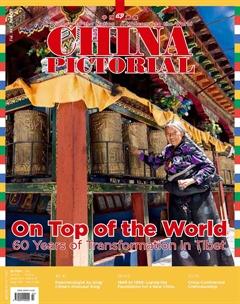Homes Where Hearts Belong
by Gong Haiying
China has a vast territory and a multitude of ethnic groups. On the long road of history, various folk houses with unique characteristics have sprouted across the country.
In 2005, Mao Ge, then an architecture student, began studying Chinese folk architecture with Luo Deyin, an associate professor of the School of Architecture at Tsinghua University.
After visiting many villages in China and seeing many kinds of folk houses, she realized that each house, with its distinct regional characteristics, was the result of artisansmeticulous and laborious efforts. In those houses, she could feel the deep love local people have for life, regardless of ethnic group, and whether rich or poor.
With the fast development of urbanization in the 1980s, reinforced concrete became the most important building material in China. Although the question of how to protect and develop traditional residential buildings has drawn wide attention and evoked heated discussions, the number of folk houses has continued declining. Along with their disappearance, the traditional construction techniques, building tools and other related architectural knowledge are also being forgotten.
After becoming so deeply attached to traditional folk houses, Mao ventured to the Polytechnic Institute of Milan in Italy to continue her studies of architectural protection. She started hoping that more and more people, especially youngsters, would understand the charm of folk architecture and become inspired to join in protection efforts.
Born in the 1980s, Mao grew up reading comic books and eventually realized that we are in an era of“fragmented information” in which people prefer to read with pictures rather than text, which gave her the idea to compile a book introducing construction knowledge on folk architecture primarily through images to kindle more interest in the subject.
Mao noted that the construction process for traditional Chinese homes depended considerably on available special techniques, and embodied the great wisdom of the working people of ancient China. Various rituals and customs related to architecture carry abundant information about traditional culture, while also reflecting peoples hopes and longing for a better life.
By referencing many academic books on traditional folk houses that contain systematic architectural information and abundant construction blueprints and photos, Mao completed Drawing Traditional Folk Houses, an educational book with simple and interesting illustrations and easy words to introduce basic knowledge of traditional Chinese folk architecture to young people, including teenagers.
By sharing information on the origin of Chinese architecture and general construction procedures and introducing eight representative types of traditional Chinese folk houses including siheyuan (residential quadrangles) in Beijing, cave dwelling courtyards in central Henan Province and tulou (earthen buildings) in southeastern Fujian Province, the book captures the unique residential culture of China.
In the preface, Professor Luo wrote that in the era of rapid development of urbanization and astonishing disappearance of the folk architecture, such a book is particularly valuable to convey the value of folk architecture to the public, especially young people. He also expressed hope that the book would play a positive role in promoting Chinese traditional architectural culture and preserving existing structures.
The author holds a bachelors degree in architecture from Tsinghua University and a masters degree in architecture from the Polytechnic Institute of Milan, Italy. She currently works for Tsinghua Tongheng Urban Planning and Design Institute in Beijing. She is also the author of Drawing Old Houses and Three Manors in Gongyi.

